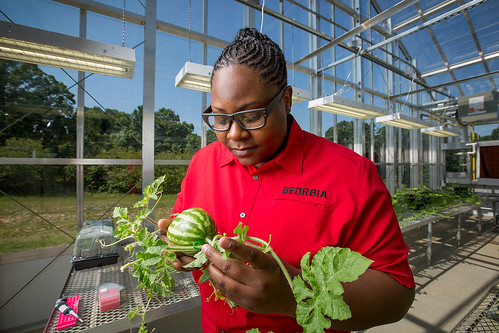
On a hot summer day, nothing tastes as good as a juicy watermelon. Safira Sutton must agree.
A doctoral student studying plant pathology, Sutton researches ways to inoculate watermelon and similar fruits in the cucurbit family against bacterial fruit blotch, which is caused by the A. citrulli bacterium.
Bacterial fruit blotch (BFB) is a devastating threat to cucurbit fruit production, particularly watermelon, cantaloupe, and honeydew. In the southeastern U.S., outbreaks of the disease can lead to severe fruit rot and significant economic loses.
Sutton is working on ways to protect watermelon seedlings against the BFB-causing bacterium, which can be introduced into melon fields by contaminated seed, infected transplants, volunteer watermelon plants, and from alternate hosts.
“Despite several types of management practices, disease management remains challenging because A. citrulli bacterium is seed borne, and seeds are the primary source of the pathogen,” Sutton explains.
Currently, management of the disease relies heavily on foliar applied chemicals and tested pathogen-free seeds.
However, under conditions of high rainfall and relative humidity- conditions typical in the southeastern U.S- the efficacy of the foliar applied chemicals can be limited.
Sutton further explains why managing the A. citrulli pathogen is difficult.
“Because the pathogen can be localized under the seed coat or in the endosperm of the seed, any externally applied seed treatment will be rendered ineffective. The treatments are also limited due to their inability to penetrate to the embryo of watermelon seeds, leaving any disease there to flourish upon planting.”
Since no one management practice can eradicate BFB alone, Dr. Ron Walcott, Sutton’s major professor, and the research team proposed a strategic addition to an integrated management plan in an effort to provide protection deep within the seed.
“Our proposal involves depositing biocontrol agents into internal tissues of seeds by depositing them on female flowers. After seed germination, the antagonists (biocontrol agents) could rapidly colonize seed tissues and prevent the establishment of A. citrulli populations.”
Sutton and her team worked with several biocontrol agents, including the Bacillus species, which was already known to limit seed to seedling transmission when applied as an external seed treatment.
During the team’s biocontrol experiment, female flowers were inoculated with the Bacillus species at pollination, and the seeds were harvested once the fruits matured.
Their findings indicate that inoculating the female flowers with the biocontrol agent during pollination resulted in seed to seedling transmission rates as low as 19 percent, whereas seeds from non-inoculated female flowers had a transmission rate of 80 percent.
Sutton’s team is also optimistic that the Bacillus species biocontrol agents can protect cucurbits from additional pathogens as well.
“Microbial organisms are known for their ability to be antagonistic against microorganisms. Because of this implication, we also looked at the usefulness of the Bacillus species to have antagonistic ability against soil borne fungi that occur frequently in Georgia and affect cucurbit production,” Sutton explains.
Results of this study provide an environmentally sound and sustainable approach for managing seed-borne plant diseases that may be of potential use for seed transplants.
“By protecting seeds from A. citrulli with biocontrol agents, we can reduce the use of chemicals,” Sutton says. “Upon completion of this research, I am hopeful that growers and seed producers can incorporate this method into their production practices, making management strategies against plant pathogens sustainable and environmentally friendly.”
After graduation, Sutton’s career aspiration is to work for Monsanto, the leading seed company in North America. She is also considering academic positions in the future to mentor students interested in plant pathology.
“I would love to motivate students as some people have motivated me. It is very rewarding to see a student’s face when you provide them with assistance, and you can see that they truly understand and appreciate your help.”
